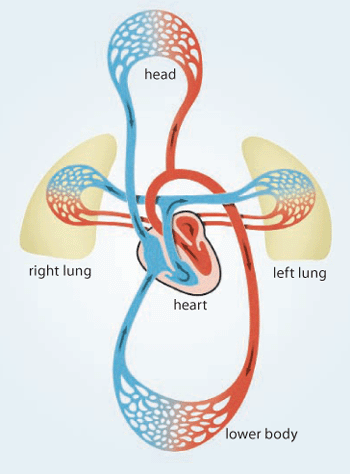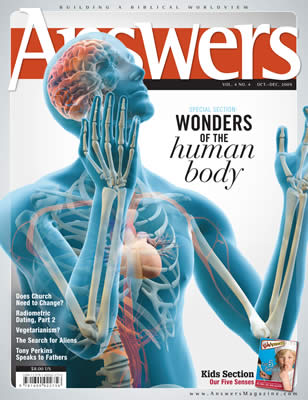Heart
Constantly Beating Death
To survive, we require a specialized pump that can deliver life-giving blood to all our body parts, day and night, year after year, without fail. To get the job done within the body of a living organism, the heart must overcome some incredible engineering challenges.

Finally you can explore human anatomy and physiology in a Creator-honoring way! Former medical university professor Dr. Menton takes two teens on a teaching-tour through the major systems of the body.
Our lives hang on a thread. A constant flow of rich blood must reach cells throughout the body, delivering oxygen and essential nutrients to our extremities, while removing waste products like carbon dioxide. Stop the flow for just a few minutes, and life will cease.
How did the Creator ensure a steady flow? He gave us a pump made of soft flesh, not of hard steel. Estimates vary, but this powerful muscle pushes blood through at least 1,500 miles (2500 km) of blood vessels, some as narrow as one red blood cell. The heart must keep beating 100,000 times a day without tiring or malfunctioning.
We are a walking miracle, exquisitely designed for life on Earth. Just consider three engineering challenges that our heart has to overcome.
Challenge #1: Running in Two Directions at Once
Blood needs to flow through two separate circuits of blood vessels at the same time. The first circuit gathers the blood from the body and sends it to the lungs so it can pick up oxygen and get rid of carbon dioxide. The second circuit picks up the oxygen-rich blood returned from the lungs and sends it to the rest of the body. But we are given only one heart to pump blood in these two directions. How can this challenge be overcome?
The Solution: Two Pumps in One

FIGURE 1—TWO PUMPS IN ONE The right side of the heart pumps blood through the lungs, while the left side pumps blood through the tissues of the head and body.
The heart is actually two pumps in one. In the mother’s womb, the baby’s heart starts out as a simple, large tube. As the baby grows, however, the Creator designed the tube so that it loops back, forming a kink. The sides fuse together, forming a wall between two separate compartments. As the rest of the heart forms, the two sides remain separate, essentially becoming two separate pumps.
Each of these pumps has its own two-chamber pumping system (Figure 1). The muscles in one chamber contract and squeeze out blood, while muscles in the other chamber relax and fill with blood. The heart continually wrings out blood by a twisting motion, like wringing a mop. Wringing out liquid is more efficient than the direct squeezing of typical man-made pumps.
The same action squeezes blood out of both pumps—filling one chamber while it empties the other chamber. But this presents a problem. The left side must create six times more force than the right side to move the blood throughout the body.1 (More force is necessary because it’s harder to move blood to the rest of the body than through the nearby lungs.) To compensate, the left side has been designed with more powerful muscles.
Challenge #2: Running in Place
The human body has an amazing ability to keep organs stable as we run, jump, and twirl. That might seem easy for kidneys or our bladder, but the heart presents an extra difficulty. It is pumping vigorously all the time. How can it keep moving without sliding around inside the ribcage or overheating?
The Solution: A Two-Layered Sac
To protect this nonstop muscle, God placed it in a special two-layered bag, called the pericardial sac. The tough outer layer of the sac, called the fibrous pericardium, anchors to the diaphragm, while the inner layer, called the serous pericardium, attaches tightly to the heart. A special lubricant fluid between the two layers allows the heart to slide around with little friction. If it were not for this marvelous lubricated sac, the beating heart would create enough heat to kill us.
The pericardial sac is just one more amazing feature that naturalistic evolution has a hard time explaining, but it makes sense within a biblical worldview.
Challenge #3: Running Continuously
The nerves responsible for our senses tire quickly. Have you ever smelled a strong odor and then stopped noticing the smell? Your nose’s nerve cells simply stopped firing. You literally stopped smelling. The nerves to the heart, in contrast, can never stop firing for as long as we live. Ever.
The Solution: A Pacemaker
How can this difficulty be resolved? God designed a separate system of nerves called the autonomic nervous system. These nerves differ from the nerves of our five senses because they continuously transmit without fail. They don’t get overwhelmed with information (like the strain on your eyes from staring too long at a bright tie-dyed shirt), so they don’t tire out.
Yet our hearts are different from typical autonomic systems. Most systems, like digestion, don’t have to run constantly. The heart, on the other hand, must function all the time. So God gave the heart a built-in pacemaker that allows it to run regularly, without active outside control.
Sitting on the upper right side of the heart is a cluster of specialized cells called the sinoatrial node. They generate electrical impulses that stimulate the muscles in the upper chambers to contract. The signal continues moving down to another cluster of cells above the lower chambers, which then fire.
These electrical impulses ebb and flow in regular waves, without the need for direct input from the brain.
If needed, however, the brain can directly control heart rate and blood pressure. The brain constantly monitors the heart to evaluate when to step in.
During a rigorous tennis game, for example, our muscles need more oxygen to burn. So the brain signals the heart directly to increase the heart rate. At the same time, the heart stimulates the adrenal glands to release the chemical adrenaline. Adrenaline then keeps the heart rate up without further assistance from the brain.
When the tennis match ends and the muscles relax, the brain signals the adrenal glands to stop producing adrenaline, and the heart rate returns to normal.

Running from the Truth
Despite the marvels of the heart’s design, something is terribly wrong. No matter how hard we try to avoid it, our heart will eventually fail. Without Christ, we are like the walking dead, just biding our time until the inevitable end.
Every heartbeat should remind us about the shortness of life. Sin has corrupted every man’s heart, and we can’t do anything to stop it. We need a new heart, both literally and spiritually.
Fortunately, the same God who designed our hearts to sustain physical life also designed a miraculous way for us to obtain a new spiritual “heart” that will beat for eternity. He sent His Son, Jesus Christ, down to this planet to become a man and shed His blood in payment for our sin. Through His sacrifice, Jesus offers the gift of eternal life to all who will trust in Him.
“I [God] will give you a new heart and put a new spirit within you; I will take the heart of stone out of your flesh and give you a heart of flesh” (Ezekiel 36:26).
A Healthy Hole
Ever wondered what a baby does with his lungs before he’s born? He can’t breathe air inside the womb. His lungs are not used. Instead, his blood vessels are temporarily attached to his mother’s placenta, where they absorb nutrients and oxygen.
The lung develops until birth, without being called upon to function. In fact, a baby can be born without lungs and survive until the placenta is removed. In contrast, the heart is critical to life from the start. It’s the only vital organ that must function from the beginning stage of its development (the heart starts beating at five weeks).
Since the baby’s heart does not yet need to devote one of its pumps to circulating blood to the lungs, the heart develops a small hole, called the foramen ovale, in the wall that separates the two pumps. The baby also develops a small vein, called the ductus arteriosus, which allows blood to bypass the lungs and move directly to the body.
At birth, a marvelous transformation takes place. When the lungs inflate and the baby takes his first breath, the pressure in the heart shifts, forcing a flap over the foramen ovale to close the hole. The body also produces chemicals that cause the bypass artery to close.
By marvelous design, the baby emerges from its watery home and breathes the air without a glitch. Blood begins pumping to the lungs to absorb oxygen without a moment’s delay.
Answers Magazine
October – December 2009
When it comes to God’s marvelous creation, nothing compares to the amazing design of the human body. From the protective garment of skin to the engineering of our bones and new discoveries about our brain, this issue is packed with testimony to the Master Designer.
Browse IssueRecommended Resources

Answers in Genesis is an apologetics ministry, dedicated to helping Christians defend their faith and proclaim the good news of Jesus Christ.
- Customer Service 800.778.3390
- Available Monday–Friday | 9 AM–5 PM ET
- © 2025 Answers in Genesis





